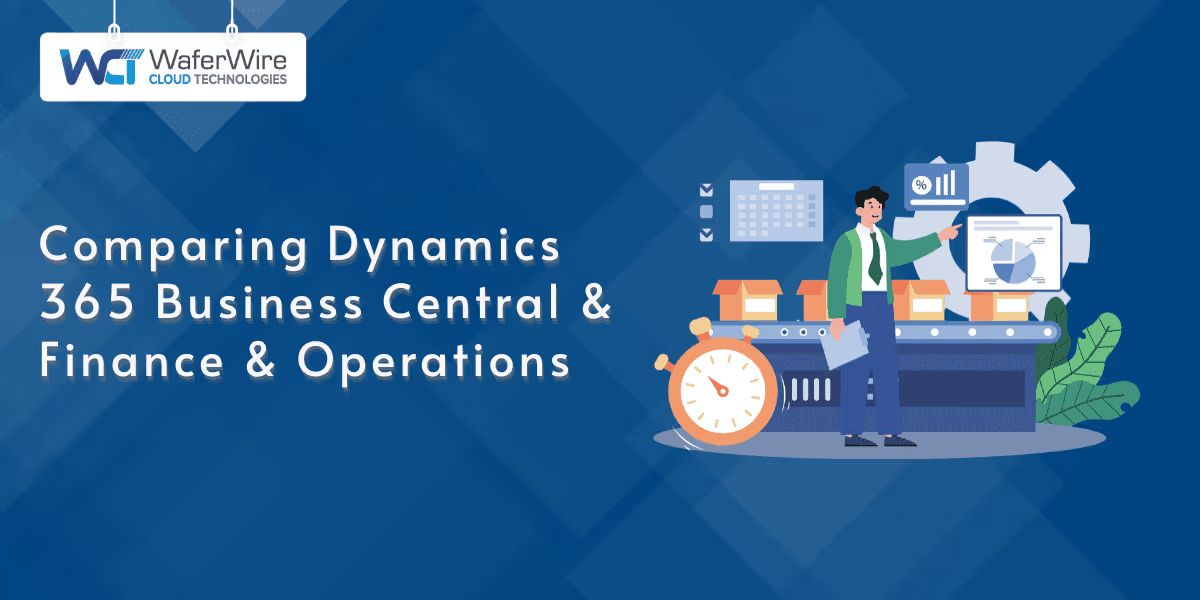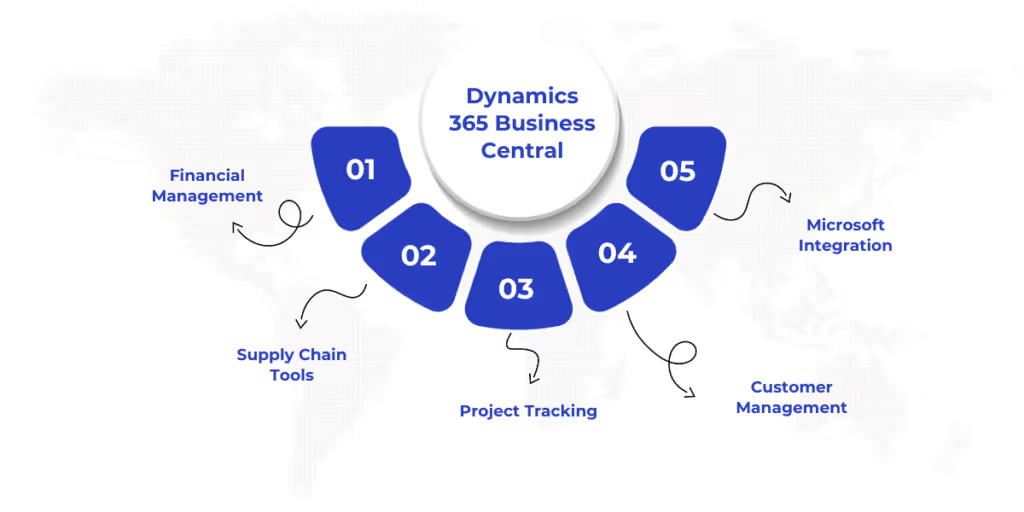

Choosing an Enterprise Resource Planning (ERP) solution is as important as selecting the ideal instrument for a complicated coding process. Choose the right one, and your company hums along. Make the wrong choice, and you experience perpetual headaches. Microsoft Dynamics 365 provides two robust ERP solutions: Business Central and Finance & Operations. Both cater to different business requirements, and their distinctions enable you to make an informed decision.
They’re both great, but they’re aimed at different kinds of businesses. We’ve put together this guide to break down microsoft dynamics 365 business central vs finance and operations, covering what they do, how much they cost (with the latest pricing), and what it takes to get them running. Let’s figure out which one’s right for you
Both Dynamics 365 Business Central and Finance & Operations are cloud-based ERP systems designed to manage key business functions like finances, inventory, and customer relationships. They differ in their focus, though. Business Central acts like a streamlined app for small to medium-sized businesses (SMBs), packing essential tools into an easy-to-use package.
Finance & Operations, though, is built for bigger companies with more complicated setups, like a pro-level software suite. If you’re a smaller business wanting something simple, Business Central might be your pick. But if you’ve got a large operation with lots going on, Finance & Operations could be the winner.
With this foundation, let’s explore Business Central’s features and how they support smaller businesses.

Business Central is Microsoft's product designed for small to mid-sized companies that need a powerful yet easy-to-use system. Consider it a toolbox that has everything you need to run your company without being overly complicated for your team. Whether you are operating a small retail store or a consulting company, Business Central can help you run it smoothly. Here are its features that all make managing your company easier:
Business Central stands out for its ease of use. The interface is clean, so your team can learn it quickly, even without a big IT staff. Its cloud-based design lets you access data from anywhere. For SMBs seeking a cost-effective, scalable solution, Business Central is a strong contender in the microsoft dynamics 365 business central vs finance and operations comparison.
Having covered Business Central, let’s shift focus to Finance & Operations and its strengths for larger organizations.
Finance & Operations is the heavy-duty option, built for companies with complex operations. It’s like upgrading from a basic calculator to a scientific one—it handles bigger challenges with more features. This ERP is designed for enterprises managing global finances or detailed manufacturing processes. Here’s what you get:
This Finance and Operations is designed for scale, which means it will require more implementation and understanding compared to Business Central. For large organizations, or organizations with specialized needs , Finance and Operations can be a strong choice if you were choosing between microsoft dynamics 365 business central vs finance and operations.
Now that you understand both systems, let’s break down their key differences to help you decide.

When comparing microsoft dynamics 365 business central vs finance and operations, their differences in functionality are critical. These distinctions highlight which system suits your business best:
These differences make your choice clear: Business Central for simplicity, Finance & Operations for complexity. Let’s move on to factors you should consider when picking one.
Choosing between these ERP systems requires weighing several factors to ensure the best fit for your business:
Consider your IT capacity too. Business Central needs less technical know-how, while Finance & Operations might require a dedicated team or external support. These considerations guide your decision in the microsoft dynamics 365 business central vs finance and operations debate.
With these factors in mind, let’s look at the costs to see how they impact your choice.
Cost is a big deal when comparing microsoft dynamics 365 business central vs finance and operations. Both use a subscription model, but their pricing reflects their different scopes. Here’s the latest breakdown from Microsoft’s official pricing pages:
Beyond subscriptions, factor in setup and maintenance. Business Central’s simpler deployment means lower initial costs, while Finance & Operations may require significant spending on consultants and training. Check Microsoft’s Finance pricing and Supply Chain Management pricing for details. These costs help you budget for the right ERP in the microsoft dynamics 365 business central vs finance and operations comparison.
Now that you’ve got the pricing, let’s explore how to implement these systems successfully.
Setting up an ERP system can shake up your operations, so a solid plan is crucial. Here’s how to approach implementation for each:
For both, involve key team members early, prioritize training, and arrange ongoing support. A well-planned rollout ensures your ERP delivers value from day one. This step is critical when choosing between microsoft dynamics 365 business central vs finance and operations.
Determining whether microsoft dynamic 365 business central versus finance and operations, narrows down to what your business currently needs and what it will need in the future. Business Central is like an old reliable app for small to medium sized businesses, offering an affordable and user-friendly platform that will grow with you.
If you are after simplicity without compromising on key features Business Central is a great choice. Finance & Operations however, was designed for larger enterprises with more complex issues to tackle, such as global finances, or complicated manufacturing requiring flexibility.
Finance & Operations has all the features essential for large enterprises to scale with big aspirations. Think about your company's size, sector, budget and growth ambitions allow you to choose the right ERP. Selecting the wrong ERP could lead to severe slow-down, but the right ERP will set you up for success.
To maximize your ERP investment, partner with experienced Microsoft Dynamics 365 professionals who can assist you from selection & configuration through to finished ergonomic customization. At WaferWire, our team of Microsoft specialists can walk you through the process of selecting, configuring, and customizing your ERP to suit your business needs. Get in touch with WaferWire today to get started on the journey towards smarter and more efficient business.
1. Can you switch from Business Central to Finance & Operations if your business grows?
Yes, you can transition from Business Central to Finance & Operations, but it’s not a simple flip of a switch. Both systems are part of the Dynamics 365 family, which helps, but they have different architectures. Moving involves migrating your data, reconfiguring workflows, and adapting to Finance & Operations’ more complex setup.
2. Which system is better suited for manufacturing businesses?
Finance & Operations is the stronger choice for manufacturing due to its advanced tools for production planning, warehouse management, and supply chain logistics. It handles complex processes like bill of materials or shop floor control, ideal for a factory producing custom machinery.
3. Is Business Central suitable for larger businesses with multiple locations?
Business Central can work for larger businesses with straightforward operations, but it has limits. Its Essentials and Premium tiers handle core functions like financials and inventory well, suitable for a chain of five retail stores. However, if you’re managing dozens of locations with complex needs, like multi-currency transactions or global compliance, Finance & Operations is better equipped.
4. How do the integration capabilities differ between the two systems?
Both systems integrate with Microsoft tools like Office 365 and Power BI, but their scope differs. Business Central offers seamless, out-of-the-box connections for SMBs, letting you pull data into Excel or create Power BI reports with minimal setup. Finance & Operations provides deeper integrations, supporting complex scenarios like connecting to Azure services for advanced analytics or custom apps for enterprise workflows.
5. What kind of support do you need to implement these systems successfully?
Implementing either ERP requires planning, but the support varies. Business Central’s simpler design means you can often deploy it with minimal help, using Microsoft’s templates and a partner’s guidance for a quick setup in weeks. Finance & Operations demands more expertise due to its complexity, often requiring a dedicated team or consultants to customize and train your staff, which can take months.

